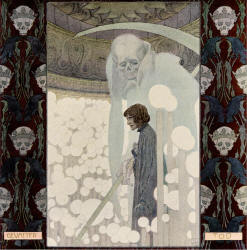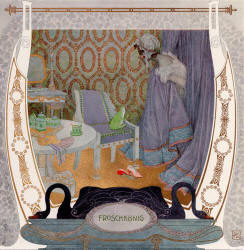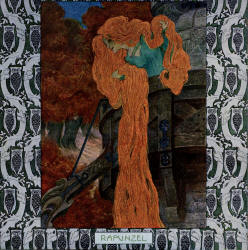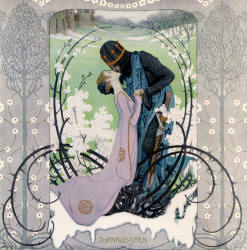http://www.pitt.edu/~dash/type0709.html
- Little Snow-White, version of 1812 (Germany,
Jacob and Wilhelm Grimm).
- Link to the 1857 version of the Grimm Brothers' Little Snow-White, translated by D. L. Ashliman.
- Link to the German-language Schneewittchen (version of 1857).
- Link to the first translation of "Sneewittchen" into English, done by Edgar Taylor in 1823, here presented in an edition of 1874: Snow-Drop. In his translation, Taylor not only changes the Grimms' title, but softens their content as well.
- Link to a Europe-wide "reconstruction" of the Grimms' tale, done by Joseph Jacobs in his Europa's Fairy Book (1916): Snowwhite.
- Gold-Tree and Silver-Tree (Scotland).
- The Young Slave (Italy, Giambattista Basile).
- Maria, the Wicked Stepmother, and the Seven Robbers (Italy).
- The Crystal Casket (Italy).
- Link to Death of the Seven Dwarfs, a folk legend from Switzerland.
- Links to related sites.
Return to D. L. Ashliman's folktexts, a library of folktales, folklore, fairy tales, and mythology.
Little Snow-White --Jacob and Wilhelm GrimmOnce upon a time in mid winter, when the snowflakes were falling like feathers from heaven, a beautiful queen sat sewing at her window, which had a frame of black ebony wood. As she sewed, she looked up at the snow and pricked her finger with her needle. Three drops of blood fell into the snow. The red on the white looked so beautiful, that she thought, "If only I had a child as white as snow, as red as blood, and as black as this frame." Soon afterward she had a little daughter that was as white as snow, as red as blood, and as black as ebony wood, and therefore they called her Little Snow-White.
Now the queen was the most beautiful woman in all the land, and very proud of her beauty. She had a mirror, which she stood in front of every morning, and asked:
Mirror, mirror, on the wall,And the mirror always said:
Who in this land is fairest of all?
You, my queen, are fairest of all.And then she knew for certain that no one in the world was more beautiful than she.
Now Snow-White grew up, and when she was seven years old, she was so beautiful, that she surpassed even the queen herself. Now when the queen asked her mirror:
Mirror, mirror, on the wall,The mirror said:
Who in this land is fairest of all?
You, my queen, are fair; it is true.When the queen heard the mirror say this, she became pale with envy, and from that hour on, she hated Snow-White. Whenever she looked at her, she thought that Snow-White was to blame that she was no longer the most beautiful woman in the world. This turned her heart around. Her jealousy gave her no peace. Finally she summoned a huntsman and said to him, "Take Snow-White out into the woods to a remote spot, and stab her to death. As proof that she is dead bring her lungs and her liver back to me. I shall cook them with salt and eat them."
But Little Snow-White is still
A thousand times fairer than you.
The huntsman took Snow-White into the woods. When he took out his hunting knife to stab her, she began to cry, and begged fervently that he might spare her life, promising to run away into the woods and never return. The huntsman took pity on her because she was so beautiful, and he thought, "The wild animals will soon devour her anyway. I'm glad that I don't have to kill her." Just then a young boar came running by. He killed it, cut out its lungs and liver, and took them back to the queen as proof of Snow-White's death. She cooked them with salt and ate them, supposing that she had eaten Snow-White's lungs and liver.
Snow-White was now all alone in the great forest. She was terribly afraid, and began to run. She ran over sharp stones and through thorns the entire day. Finally, just as the sun was about to set, she came to a little house. The house belonged to seven dwarfs. They were working in a mine, and not at home. Snow-White went inside and found everything to be small, but neat and orderly. There was a little table with seven little plates, seven little spoons, seven little knives and forks, seven little mugs, and against the wall there were seven little beds, all freshly made.
Snow-White was hungry and thirsty, so she ate a few vegetables and a little bread from each little plate, and from each little glass she drank a drop of wine. Because she was so tired, she wanted to lie down and go to sleep. She tried each of the seven little beds, one after the other, but none felt right until she came to the seventh one, and she lay down in it and fell asleep.
When night came, the seven dwarfs returned home from the work. They lit their seven little candles, and saw that someone had been in their house.
The first one said, "Who has been sitting in my chair?"
The second one, "Who has been eating from my plate?"
The third one, "Who has been eating my bread?"
The fourth one, "Who has been eating my vegetables?"
The fifth one, "Who has been sticking with my fork?"
The sixth one, "Who has been cutting with my knife?"
The seventh one, "Who has been drinking from my mug?"
Then the first one said, "Who stepped on my bed?"
The second one, "And someone has been lying in my bed."
And so forth until the seventh one, and when he looked at his bed, he found Snow-White lying there, fast asleep. The seven dwarfs all came running, and they cried out with amazement. They fetched their seven candles and looked at Snow-White. "Good heaven! Good heaven!" they cried. "She is so beautiful!" They liked her very much. They did not wake her up, but let her lie there in the bed. The seventh dwarf had to sleep with his companions, one hour with each one, and then the night was done.
When Snow-White woke up, they asked her who she was and how she had found her way to their house. She told them how her mother had tried to kill her, how the huntsman had spared her life, how she had run the entire day, finally coming to their house. The dwarfs pitied her and said, "If you will keep house for us, and cook, sew, make beds, wash, and knit, and keep everything clean and orderly, then you can stay here, and you'll have everything that you want. We come home in the evening, and supper must be ready by then, but we spend the days digging for gold in the mine. You will be alone then. Watch out for the queen, and do not let anyone in."
The queen thought that she was again the most beautiful woman in the land, and the next morning she stepped before the mirror and asked:
Mirror, mirror, on the wall,The mirror answered once again:
Who in this land is fairest of all?
You, my queen, are fair; it is true.It startled the queen to hear this, and she knew that she had been deceived, that the huntsman had not killed Snow-White. Because only the seven dwarfs lived in the seven mountains, she knew at once that they must have rescued her. She began to plan immediately how she might kill her, because she would have no peace until the mirror once again said that she was the most beautiful woman in the land. At last she thought of something to do. She disguised herself as an old peddler woman and colored her face, so that no one would recognize her, and went to the dwarf's house. Knocking on the door she called out, "Open up. Open up. I'm the old peddler woman with good wares for sale."
But Little Snow-White beyond the seven mountains
Is a thousand times fairer than you.
Snow-White peered out the window, "What do you have?"
"Bodice laces, dear child," said the old woman, and held one up. It was braided from yellow, red, and blue silk. "Would you like this one?"
"Oh, yes," said Snow-White, thinking, "I can let the old woman come in. She means well." She unbolted the door and bargained for the bodice laces.
"You are not laced up properly," said the old woman. "Come here, I'll do it better." Snow-White stood before her, and she took hold of the laces and pulled them so tight that Snow-White could not breathe, and she fell down as if she were dead. Then the old woman was satisfied, and she went away.
Nightfall soon came, and the seven dwarfs returned home. They were horrified to find their dear Snow-White lying on the ground as if she were dead. They lifted her up and saw that she was laced up too tightly. They cut the bodice laces in two, and then she could breathe, and she came back to life. "It must have been the queen who tried to kill you," they said. "Take care and do not let anyone in again."
The queen asked her mirror:
Mirror, mirror, on the wall,The mirror answered once again:
Who in this land is fairest of all?
You, my queen, are fair; it is true.She was so horrified that the blood all ran to her heart, because she knew that Snow-White had come back to life. Then for an entire day and a night she planned how she might catch her. She made a poisoned comb, disguised herself differently, and went out again. She knocked on the door, but Snow-White called out, "I am not allowed to let anyone in."
But Little Snow-White with the seven dwarfs
Is a thousand times fairer than you.
Then she pulled out the comb, and when Snow-White saw how it glistened, and noted that the woman was a complete stranger, she opened the door, and bought the comb from her. "Come, let me comb your hair," said the peddler woman. She had barely stuck the comb into Snow-White's hair, before the girl fell down and was dead. "That will keep you lying there," said the queen. And she went home with a light heart.
The dwarfs came home just in time. They saw what had happened and pulled the poisoned comb from her hair. Snow-White opened her eyes and came back to life. She promised the dwarfs not to let anyone in again.
The queen stepped before her mirror:
Mirror, mirror, on the wall,The mirror answered:
Who in this land is fairest of all?
You, my queen, are fair; it is true.When the queen heard this, she shook and trembled with anger, "Snow-White will die, if it costs me my life!" Then she went into her most secret room -- no one else was allowed inside -- and she made a poisoned, poisoned apple. From the outside it was red and beautiful, and anyone who saw it would want it. Then she disguised herself as a peasant woman, went to the dwarfs' house and knocked on the door.
But Little Snow-White with the seven dwarfs
Is a thousand times fairer than you.
Snow-White peeped out and said, "I'm not allowed to let anyone in. The dwarfs have forbidden it most severely."
"If you don't want to, I can't force you," said the peasant woman. "I am selling these apples, and I will give you one to taste."
"No, I can't accept anything. The dwarfs don't want me to."
"If you are afraid, then I will cut the apple in two and eat half of it. Here, you eat the half with the beautiful red cheek!" Now the apple had been so artfully made that only the red half was poisoned. When Snow-White saw that the peasant woman was eating part of the apple, her desire for it grew stronger, so she finally let the woman hand her the other half through the window. She bit into it, but she barely had the bite in her mouth when she fell to the ground dead.
The queen was happy, went home, and asked her mirror:
Mirror, mirror, on the wall,And it answered:
Who in this land is fairest of all?
You, my queen, are fairest of all."Now I'll have some peace," she said, "because once again I'm the most beautiful woman in the land. Snow-White will remain dead this time."
That evening the dwarfs returned home from the mines. Snow-White was lying on the floor, and she was dead. They loosened her laces and looked in her hair for something poisonous, but nothing helped. They could not bring her back to life. They laid her on a bier, and all seven sat next to her and cried and cried for three days. They were going to bury her, but they saw that she remained fresh. She did not look at all like a dead person, and she still had beautiful red cheeks. They had a glass coffin made for her, and laid her inside, so that she could be seen easily. They wrote her name and her ancestry on it in gold letters, and one of them always stayed at home and kept watch over her.
Snow-White lay there in the coffin a long, long time, and she did not decay. She was still as white as snow and as red as blood, and if she had been able to open her eyes, they still would have been as black as ebony wood. She lay there as if she were asleep.
One day a young prince came to the dwarfs' house and wanted shelter for the night. When he came into their parlor and saw Snow-White lying there in a glass coffin, illuminated so beautifully by seven little candles, he could not get enough of her beauty. He read the golden inscription and saw that she was the daughter of a king. He asked the dwarfs to sell him the coffin with the dead Snow-White, but they would not do this for any amount of gold. Then he asked them to give her to him, for he could not live without being able to see her, and he would keep her, and honor her as his most cherished thing on earth. Then the dwarfs took pity on him and gave him the coffin.
The prince had it carried to his castle, and had it placed in a room where he sat by it the whole day, never taking his eyes from it. Whenever he had to go out and was unable to see Snow-White, he became sad. And he could not eat a bite, unless the coffin was standing next to him. Now the servants who always had to carry the coffin to and fro became angry about this. One time one of them opened the coffin, lifted Snow-White upright, and said, "We are plagued the whole day long, just because of such a dead girl," and he hit her in the back with his hand. Then the terrible piece of apple that she had bitten off came out of her throat, and Snow-White came back to life.
She walked up to the prince, who was beside himself with joy to see his beloved Snow-White alive. They sat down together at the table and ate with joy.
Their wedding was set for the next day, and Snow-White's godless mother was invited as well. That morning she stepped before the mirror and said:
Mirror, mirror, on the wall,She was horrified to hear this, and so overtaken with fear that she could not say anything. Still, her jealousy drove her to go to the wedding and see the young queen. When she arrived she saw that it was Snow-White. Then they put a pair of iron shoes into the fire until they glowed, and she had to put them on and dance in them. Her feet were terribly burned, and she could not stop until she had danced herself to death.
Who in this land is fairest of all?
The mirror answered:
You, my queen, are fair; it is true.
But the young queen
Is a thousand times fairer than you.
- Source: Kinder- und Hausmärchen, 1st ed. (Berlin: Realschulbuchhandlung, 1812), v. 1, no. 53, pp. 238-50.
- Translated by D. L. Ashliman. © 1998-2002.
- A note about the Grimms' name "Sneewittchen": Both elements of this compound word are in Low German, although the tale itself was recorded in High German. The High German form of the heroine's name would be Schneeweißchen. The Grimms used both forms in their first edition, titling the story "Sneewittchen (Schneeweißchen)."
- Some differences between the edition of 1812 and later versions:
- Beginning with the edition of 1819, the Grimms add the statement that Snow-White's mother died during childbirth, and that her father remarried. Note that in the first edition, presumably the version closest to its oral sources, Snow-White's jealous antagonist is her own mother, not a stepmother.
- Beginning with the edition of 1819, the poisoned apple is dislodged when a servant accidentally stumbles while carrying the coffin to the prince's castle.
- Link to the Grimm Brothers Home Page
Snow White: A Tale of Terror is a 1997 American horror television film based on the "Snow White" fairy tale. Also known as Snow White in the Black Forest,[1] it was directed by Michael Cohn and stars Sigourney Weaver, Sam Neill and Monica Keena. The original music score was composed by John Ottman. The film was marketed with the tagline "The fairy tale is over." The film received mixed reviews, but is praised for staying with the dark formulae that were once present in fairy tales.
Snow White: A Tale Of Terror subdivx
porsiempreorgulloyprejuicio.blogspot.com/2013/05/snow-white-tale-of-terror-1997










